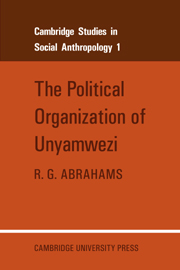Book contents
- Frontmatter
- Contents
- List of Tables
- List of Illustrations
- Foreword
- Preface
- Map of Unyamwezi
- 1 The People and their Country
- 2 The Historical Background
- 3 The External Situation
- 4 The Structure of the Chiefdom
- 5 The Business of Government
- 6 Mechanisms of Continuity
- 7 Rulers and Subjects
- 8 Neighbourhood and Politics
- 9 Conclusions
- Appendix A List of Chiefdoms in Unyamwezi
- Appendix B Nyamwezi Kinship Terminology
- Bibliography
- Index
9 - Conclusions
Published online by Cambridge University Press: 11 November 2009
- Frontmatter
- Contents
- List of Tables
- List of Illustrations
- Foreword
- Preface
- Map of Unyamwezi
- 1 The People and their Country
- 2 The Historical Background
- 3 The External Situation
- 4 The Structure of the Chiefdom
- 5 The Business of Government
- 6 Mechanisms of Continuity
- 7 Rulers and Subjects
- 8 Neighbourhood and Politics
- 9 Conclusions
- Appendix A List of Chiefdoms in Unyamwezi
- Appendix B Nyamwezi Kinship Terminology
- Bibliography
- Index
Summary
The main body of this study has been devoted to a detailed discussion of the political organization of Unyamwezi. In this final chapter I want to consider some of the points in my account which seem to be of comparative or theoretical interest.
The Nyamwezi are a multi-chiefdom tribe. Such tribes are common in East Africa and especially in Tanganyika, where, in addition to the Nyamwezi and Sukuma, we find such well-known peoples as the Ha, Haya, Zinza, and Nyakyusa. Richards has pointed out that such tribes pose particular problems for a Central Government mainly because of the small size of their traditionally autonomous political units. The efforts of the British to create a small number of larger chiefdoms and to link these into federations are ample testimony to the existence of these problems in the Nyamwezi area.
Yet, although these multi-chiefdom peoples share the common feature of being subdivided into a number of comparatively small and mutually independent chiefdoms, the proliferation of these chiefdoms has not followed the same pattern in all cases. Admittedly there is in all their histories an initial period in which a number of ruling dynasties of diverse origins are established. This preliminary settlement, however, is followed by distinctive types of chiefdom fission. A short comparison will illustrate this point.
- Type
- Chapter
- Information
- The Political Organization of Unyamwezi , pp. 173 - 186Publisher: Cambridge University PressPrint publication year: 1967

